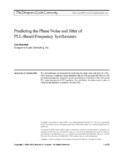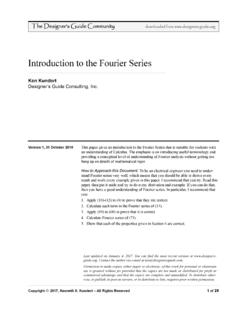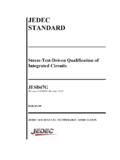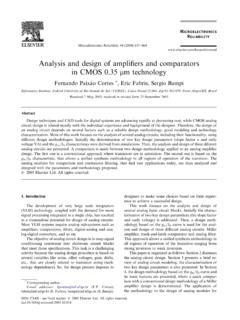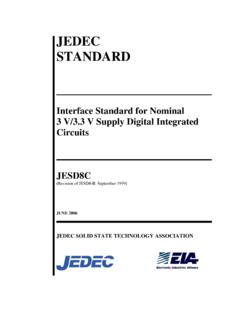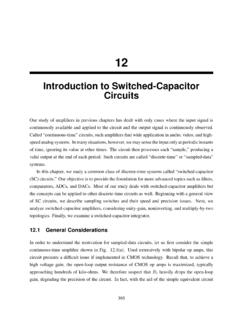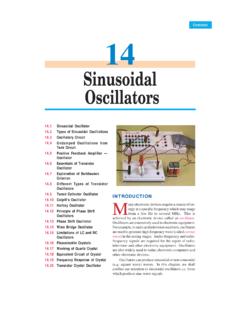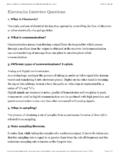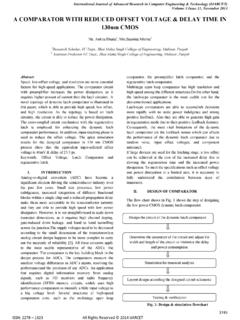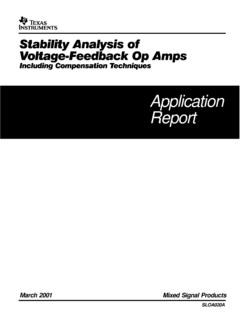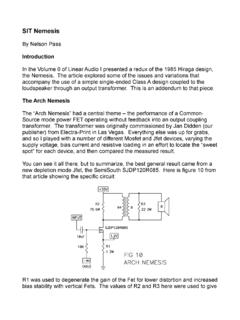Transcription of Modeling Jitter in PLL-based Frequency Synthesizers
1 The Designer s Guide Communitydownloaded from 2002-2012, Kenneth S. Kundert All Rights Reserved1 of 32 Version 4h, March 2012A methodology is presented for Modeling the Jitter in a Phase-Locked Loop (PLL) that is both accurate and efficient. The methodology begins by characterizing the noise behavior of the blocks that make up the PLL using transistor-level simulation. For each block, the Jitter is extracted and provided as a parameter to behavioral models for inclu-sion in a high-level simulation of the entire PLL. This approach is efficient enough to be applied to PLLs acting as Frequency Synthesizers with large divide paper was written in August, 2002 and was last updated on March 28, 2012.
2 You can find the most recent version at Contact the author via e-mail at to make copies, either paper or electronic, of this work for personal or classroom use is granted without fee provided that the copies are not made or distributed for profit or commercial advantage and that the copies are complete and unmodified. To distribute other-wise, to publish, to post on servers, or to distribute to lists, requires prior written s Guide is a registered trademark of Kenneth S. Kundert. All rights Jitter in PLL-based Frequency SynthesizersKen KundertDesigner s Guide Consulting, Jitter in PLL-based Frequency SynthesizersIntroduction2 of 32 The Designer s Guide Introduction Phase-locked loops (PLLs) are used in wireless receivers to implement a variety of functions, such as Frequency synthesis, clock recovery, and demodulation.
3 One of the major concerns in the design of PLLs is noise or Jitter performance. Jitter from the PLL directly acts to degrade the noise floor and selectivity of a transceiver. Demir proposed an approach for Modeling PLLs whereby a PLL is described using high level behavioral models [1,2]. The models are written such that they include Jitter in an efficient way. He also devised a powerful new simulation algorithm that is capable of characterizing the circuit-level noise behavior of blocks that make up a PLL that is based on solving a set of nonlinear stochastic differential equations [3,5].
4 Finally, he gave formulas that can be used to convert the results of the noise simulations on the individual blocks into values for the Jitter parameters for the corresponding behavioral models [6]. This approach provides accurate and efficient prediction of PLL Jitter behavior once the noise behavior of the blocks has been characterized. However, it requires the use of an experimental simulator that is not readily paper presents the relevant ideas of Demir, but while he focussed on presenting the conceptual aspects of Modeling and simulating Jitter in PLLs, this paper concentrates more on the practical aspects.
5 It presents all the information a designer would need to predict the noise and Jitter of a PLL synthesizer . This paper is an enhanced version of two previous papers [14,15]. The Jitter extraction methodology is based on the commer-cially available Spectre RF1 simulator [24,25] and presents behavioral models for Ver-ilog-A2, a standard, non-proprietary analog behavioral Modeling language [12,27]. Both SpectreRF and Verilog-A are options to the Spectre circuit simulator [11], available from Cadence Design Predicting Noise in PLLsThere are two different approaches to Modeling noise in PLLs.
6 One approach is to for-mulate the models in terms of the phase of the signals, producing what are referred to as phase-domain models. In the simplest case, these models are linear and analyzed easily in the Frequency domain, making it simple to use the model to predict phase noise, even in the presence of flicker noise or other noise sources that are difficult to model in the time domain. Phase domain models are described more fully in the companion to this manuscript [16].The other approach formulates the models in terms of voltage, and so are referred to as voltage-domain models.
7 The advantage of voltage-domain models is that they can be refined to implementation. In other words, as the design process transitions to being 1. Spectre is a registered trademark of Cadence Design Verilog is a registered trademark of Cadence Design Systems licensed to SpectreRF is currently the only commercial simulator that is well suited for characterizing the Jitter of the blocks that make up a PLL. SPICE and its descendants are not suitable because they only perform noise analysis about a DC operating point and so do not take into account the time-varying nature of these circuits.
8 Harmonic balance simulators do perform noise analysis about a periodic operating point, which is a critical prerequisite, but they have convergence, accuracy, and performance problems with blocks such as the PFD/CP, FD and VCO that are strongly SynthesisModeling Jitter in PLL-based Frequency Synthesizers3 of 32 The Designer s Guide of a verification process, the abstract behavioral models initially used can be replaced with detailed gate- or transistor-level models in order to verify the PLL as implemented.
9 Voltage-domain models are strongly nonlinear and never have quiescent operating points, making them incompatible with a SPICE-like noise analysis. Often they do have a periodic operating point and so can be analyzed with small-signal RF noise analysis (SpectreRF), but it is also common for that not to be the case. For example, a fractional-N synthesizer does not have a periodic operating point. Occasionally, the circuit is sensi-tive enough that the noise affects the large-signal behavior of the PLL, such as with bang-bang clock-and-data recovery PLLs, which invalidates any use of small-signal noise large-signal noise in a voltage-domain model as a voltage or a current is prob-lematic.
10 Such signals are very small and continuously, and generally rapidly varying. Extremely tight tolerances and small time steps are required to accurately resolve such signals with simulation. To overcome these problems, the noise is instead represented using the effect it has on the timing of the transitions within the PLL. In other words, the noise is added to the circuit in the form of Jitter . In this case there is no need for either small time steps or tight tolerances. The process of predicting the Jitter of a PLL described in this paper involves:1.
